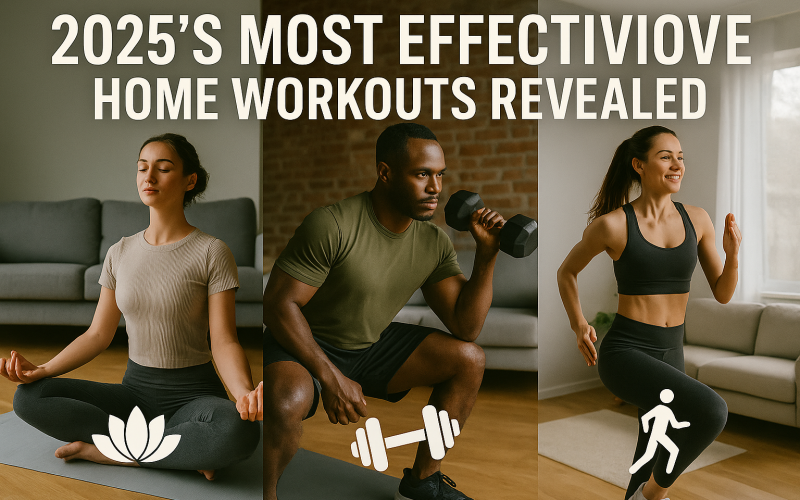Introduction
Staying fit at home has never been easier. In 2025, home workouts 2025 include fresh routines and smart tools to help everyone—from beginners to veterans. You no longer need a full gym. With simple gear and guided plans, you can improve strength, endurance, and flexibility all under your roof. This guide reveals the most effective home workouts of the year. You will learn key benefits, top routines, and expert fitness tips. By the end, you’ll know how to choose and customize exercises that fit your goals and schedule. Let’s get started.
What Are the Key Benefits of Home Workouts in 2025?
Home workouts offer freedom and variety. You save commute time and control your schedule. With smart apps, live classes, and on-demand videos, you can follow top trainers from your living room.
Doing 2025 home exercise routines improves both physical and mental health. Short sessions of high intensity can burn calories fast. Gentle flows and stretches ease stress and boost focus. This mix of styles helps you build consistency.
Home workouts also adapt to your space and needs. You can scale exercises by using resistance bands or bodyweight. This flexibility makes it easier to progress and avoid plateaus. Plus, tracking apps record your results so you see real gains over time.
What Equipment Do You Need for Effective Home Exercise?

You don’t need a lot of gear to start. A yoga mat or carpeted spot gives you grip and cushioning. Resistance bands come in light, medium, or heavy levels to match your strength.
Dumbbells or kettlebells add weight for strength training at home. Start with lighter weights—5 to 10 pounds—and work up. A pull-up bar that fits your doorframe lets you target your back and arms.
If you want more gear, consider a jump rope or a set of adjustable dumbbells. These take up little space and offer wide exercise options. For cardio, an exercise bike or compact treadmill can help—but only if you have room.
Tip: Focus on versatile tools rather than bulky machines. That way, you can switch routines quickly and keep your space tidy.
What Are the Top Bodyweight Routines?
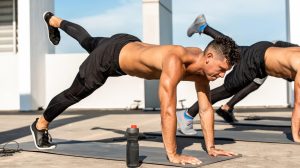
Bodyweight routines remain a staple for home fitness. They rely on your own weight to build strength and stamina. Classic moves include push-ups, squats, lunges, and planks.
A basic circuit might start with 15 squats, 10 push-ups, and a 30-second plank. Rest for one minute, then repeat three to five times. This simple plan works your entire body without any equipment.
To challenge yourself, try variations like decline push-ups, pistol squats, and side planks. Mixing in dynamic moves—like jumping lunges or burpees—raises your heart rate and boosts calorie burn.
Tip: Keep perfect form. Good technique prevents injury and maximizes each move’s benefit. If you feel pain, switch to an easier variation until you build strength.
What Are the Best HIIT Home Workouts?

High-Intensity Interval Training, or HIIT home workouts, pack big results into short sessions. You alternate between intense bursts and rest periods. A common format is 20 seconds on, 10 seconds off.
Try a 10-minute HIIT session with exercises like high knees, mountain climbers, and squat jumps. This quick blast pushes your metabolism so you burn calories even after you finish.
For a longer session, set a 20-minute timer. Do 40 seconds of work and 20 seconds of rest. Choose five moves—burpees, push-ups, jump squats, plank jacks, and tuck jumps—and cycle through.
Tip: Warm up before you start and cool down afterward. A 3-minute warm-up of light jogging or arm circles reduces injury risk. End with 3 minutes of gentle stretching.
What Are the Best Yoga and Flexibility Workouts?
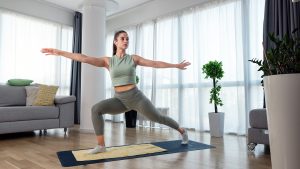
Yoga at home brings strength and calm. In 2025, many apps offer guided classes for all levels. You can choose power flows, yin stretches, or mixed sessions.
A basic routine might begin with sun salutations to warm up. Then move into warrior poses, chair pose, and gentle backbends. Finish with seated twists and a final Savasana.
Flexibility sequences focus on holding stretches for one to two minutes. This practice loosens tight hips, hamstrings, and shoulders. It also improves posture and breathing.
Tip: Breathe deeply and stay mindful. Yoga is as much about mental focus as it is about movement. Let your mind rest in each pose.
What Low-Impact Cardio Options Shine in 2025?
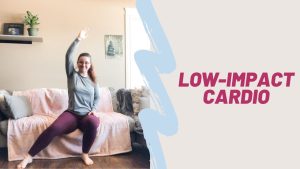
Not everyone can handle high-impact moves. Low-impact cardio gives you a solid workout with less joint stress. Options include brisk walking in place, step-ups on a sturdy box, and seated cardio routines.
Shadow boxing—throwing light punches into the air—raises your heart rate while you stay gentle on the knees. Dance-based workouts are another fun choice. Apps now offer guided dance classes in styles from hip-hop to salsa.
A 30-minute low-impact session can burn up to 250 calories. It also helps improve balance and coordination. You can mix these workouts into your week for active recovery after more intense days.
Tip: Keep your core engaged and maintain good posture. Even low-impact moves work best when you stay upright and alert.
What Strength Training Methods Work Without a Gym?
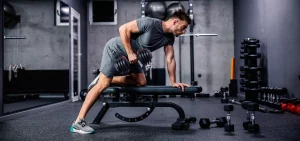
Building muscle at home is easy with the right methods. Strength training at home can use dumbbells, bands, or household items like water jugs.
Try supersets: pair two exercises—like biceps curls and triceps dips—back to back. Rest for one minute, then repeat three sets. This approach saves time and keeps your muscles challenged.
For lower body, do split squats or Bulgarian split squats using a chair. For your core, use hollow holds and bicycle crunches. You can ramp up intensity by slowing down each rep or pausing at the hardest part of the move.
Tip: Track your weights and reps in a notebook or app. Gradually increase load or reps to keep making gains.
What Online Fitness Programs Are Leading the Way?

The best online fitness programs in 2025 blend live coaching with on-demand sessions. Platforms like FitStream and MoveMore offer classes in yoga, HIIT, strength, and dance. You can join group challenges or train one-on-one with a coach.
Some apps use AI to suggest workouts based on your history and goals. They adjust difficulty and rest periods automatically. Others let you compete on leaderboards to stay motivated.
Virtual reality workouts are also emerging. With a VR headset, you can box, climb, or row in immersive digital worlds. This tech adds fun and focus to home training.
Tip: Try free trials to find a program you enjoy. Consistency matters more than style. Choose one you look forward to each day.
Below is a quick overview of key workout categories in 2025. The table shows each type, its main focus, and average session time to help you pick the best routine.
| Workout Type | Main Focus | Avg. Session Time |
|---|---|---|
| Bodyweight Routines | Strength, endurance | 20–30 minutes |
| HIIT | Fat burn, cardio fitness | 10–20 minutes |
| Yoga & Flexibility | Mobility, stress relief | 30–45 minutes |
| Low-Impact Cardio | Joint health, calorie burn | 20–30 minutes |
| Strength Training | Muscle gain, bone health | 30–40 minutes |
| Online Fitness Programs | Guided variety, motivation | 20–60 minutes |
What Tips Can Boost Your Home Workout Results?
Consistency is key. Pick a set time each day for your routine and stick to it. Treat your workout like an important appointment.
Set clear goals. Use numbers—like “do 50 push-ups” or “hold a plank for two minutes.” Seeing progress in black and white keeps you motivated.
Fuel your body well. Eat a balanced meal or snack before and after exercise. Protein helps repair muscles, while carbs give you energy.
Rest matters too. Give yourself at least one full rest day each week. On lighter days, do gentle stretching or a short walk.
Tip: Join an online community or find a workout buddy. Sharing goals and wins makes you more likely to stick with your plan.
Conclusion
Home workouts in 2025 offer something for everyone. Whether you choose bodyweight routines, HIIT home workouts, or yoga at home, you can find a plan that fits your schedule and goals. Add low-impact cardio or strength sessions to round out your week. Use online fitness programs for guidance and accountability. Focus on consistency, proper fuel, and rest to see real results. With the right mix of routines and tools, these effective home workouts will keep you healthy and strong all year long.
Call-to-Action (CTA):
Ready to transform your fitness? Sign up today for our free 7-day home workout challenge and start seeing results!






